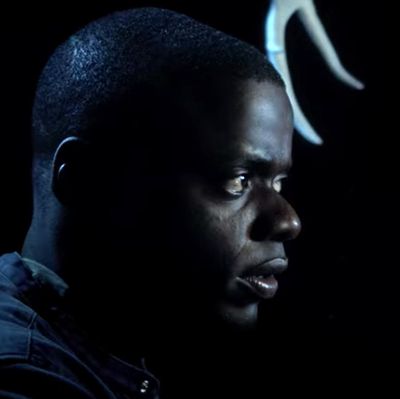
This post contains major spoilers for Get Out.
Jordan Peele’s Get Out is the rarest kind of movie, one that presents audiences with something we’ve never seen before. The film follows a black man, Chris, who goes home to meet his white girlfriend’s parents and falls into an elaborate trap. A veteran comedian, Peele uses humor to keep viewers engaged as he builds a narrative around a most insidious villain: the veiled racism of white liberal elites. From the hero to the setting to the nature of the beast at the movie’s core, Get Out subverts the genre in fundamental ways, providing the best example of why horror will be our most powerful form of screen activism in this period of raw and rampant social unrest.
In her 2011 book Horror Noire: Blacks in American Horror Films From 1890s to Present, Robin R. Means Coleman chronicles 120 years of black representation in the genre, and what she finds is chilling. With the exception of a few brief eras — the empowerment narratives that proliferated during the Blaxploitation boom of the 1970s, the “whole and full, diverse and complex” presentation of blackness in the urban horror wave of the 1990s — the story of black characters in horror (and, frankly, Hollywood in general) has been one of erasure, whitewashing, or gross and damaging misrepresentation.
But starting with his protagonist, Peele flips the genre on its head. Daniel Kaluuya’s Chris is a promising photographer spending a weekend in the suburbs, a place black characters have largely been barred from in horror films. (They were nowhere to be found in the teen slasher era’s endless residential sprawl.) And he avoids falling into the genre’s hoariest tropes. He doesn’t die first. His story is not catalyzed by violence against a black woman. He is not a brutal beast, or a sexual maniac. Instead of a hunter, he is the hunted — but what makes him prey is not his racial inferiority. In a novel twist, Chris is a target because of his perceived superiority in almost every way.
Early films like A Nigger in the Woodpile (1904) were packaged as comedies for white audiences, but for black viewers they were horror films, with disgusting illustrations of black characters (often played by white actors in blackface). It wasn’t until 1968, when George A. Romero cast Duane Jones as the lead in Night of the Living Dead, that a black man starred in a major horror film. Jones was presented as capable, strong, decisive, and trustworthy — which still didn’t save him from being shot dead by an angry mob in the end. But little changed after Living Dead: Black characters still lived and died at the whims of white ones, and were typically presented as either intellectually inferior, entirely expendable, or both. As Coleman observes, the tropes were switched up the black-focused films of the 1990s: In movies like Tales From the Hood and Def by Temptation “it was Whiteness that became the symbol of deficiency,” with white characters filling the sidekick, buffoon, and villain roles long assigned to black performers.
In Get Out, though, the collection of white people that Chris encounters aren’t so obviously abhorrent. Their racism is rooted not in the brutality of lynch mobs but is instead disguised as progressiveness. Their bigotry grows out of entitlement and appropriation. They covet Chris as a kind of fetish object, seeing him only as a composite of myths they’ve heard about enhanced sexual prowess and innate physical superiority. They see cultural capital and a “cool factor” in him that they can’t replicate. It is black excellence that the white people in Get Out desire. Even as they’re about to do unspeakable things to him, they’re convinced Chris should be honored by the attention.
This is a kind of violence we rarely see presented onscreen, the endless series of microaggressions that largely define how people of color, women, and those in the queer community interact with the world every day. The choice to set the film right now now also stands out. You don’t have to look far to find a film about black people overcoming racism that happened safely in the past, but that Peele uses his film to take aim at current forms of degradation — the ones that aren’t so glaringly sinister as men in white hoods — makes Get Out an exceptional entry in the genre.
“Any kind of phase that horror goes through seems to have some kind of social allegory going on,” Peele told Vulture recently. “The big risk here [is] to do something this on the nose. Normally you would hide some racial discussion in something that isn’t so obvious, something about DNA or monsters.” Instead, he ditched monsters in favor of rich white guys with God complexes — something equally frightening.
Get Out happens to be the first in a wave of socially conscious thrillers that wrap a narrative of fear around the gross indignities of everyday life. In the French film Raw, which hits our shores in March, cannibalism is a metaphor for women coming into their emotional and intellectual own. In the Sundance movie Bitch, a housewife hemmed in by domestic commitments takes on the characteristics of a dog and begins living on all fours. In all of these movies, the villains are intimately connected to our heroes; the great horror struggle of our age is not “man versus outsider” but “man versus neighbor.” Even in your own home, you’re not safe from danger.
Earlier indies like Teeth and Felt took similar approaches to the mundane horrors of living while female, but just as the language of identity politics has increasingly entered public discourse, now higher-profile horror films are entering the fray. The Nicolas Winding Refn–produced Maniac Cop remake will turn a 1970s exploitation movie into an examination of police brutality, and with Donald Trump already announcing that his reelection campaign will share the same tagline as The Purge: Anarchy — “Keep America Great” — the fourth film in James DeMonaco’s franchise is practically writing itself. Peele himself has no intention of leaving social-commentary horror behind. “Pretty much all of my ideas are in this category I would call ‘social thriller,’” he explains. “What human beings are capable of when we get together can be the most beautiful thing in the world, or it can be the most evil demon that we have to deal with. I intend to make a series of films that all deal with this social thriller, the demon that is us.”
Discrimination is all around us, but unless it affects you personally, it’s easy to miss — until there’s a glitch. Horror films are the sledgehammer of cinema; they can create those glitches, force people to stop and examine the conflicts around them in all their grisly reality. As Coleman says in Horror Noire, “Horror has always been attentive to social problems in rather provocative ways,” and says she saw the ostensibly “post-racial” era at the end of the last decade as “an ideal moment for digging into this filmmaking, race-making, and ideology-making phenomenon.”
Much has changed in the six years since Horror Noire was published. The nastiness of the presidential election, paired with the subsequent entrance of Donald Trump into the White House, exposed the idea of the “post-racial era” as the lie it always was. It’s a decades-old truism that horror films respond acutely to conservative governments, but that doesn’t change the fact that the genre looks to be increasingly vital in the coming years. The Vietnam era brought about the nihilistic violence of Last House on the Left and The Hills Have Eyes; the monolithic super-killers of the Reagan years had Jason Voorhees and Michael Meyers acting as sin hunters for the moral majority, culling the wicked, oversexed youth; and the Bush years saw the horror of the War on Terror mirrored in the torture-porn run of Saw and its imitators. Now, we have Trump, whose version of right-wing nationalism has turned newspaper front pages into chronicles of dystopia. Peele’s “social thriller” seems like the most appropriate artistic response.
“Fear is such a compelling emotion, one that is used for a lot of evil,” Peele explains. “But I feel like in art, in horror movies, fear is used in a positive way. It’s used to entertain and it’s used to help us look at our own fears, our own horrors, in a way that helps us get through them. Story is an opportunity to see life through someone else’s eyes. If it feels real and it feels grounded, there is a catharsis. A broadening of someone’s perspective is possible.”


